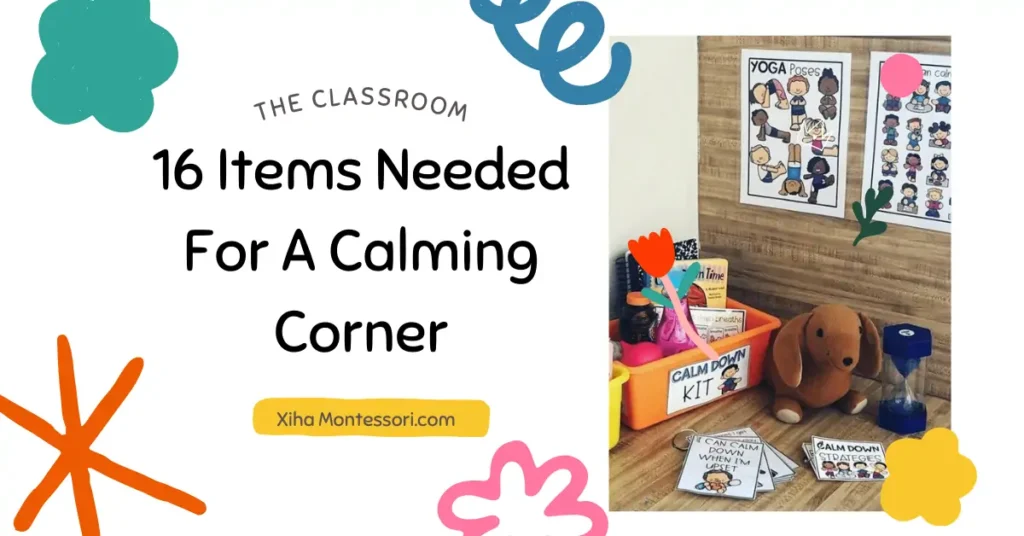Creating a calming corner in your classroom can impact students’ well-being and performance. By providing a safe space for students to relax and recharge, a calming corner can help them manage stress and encourage focus and productivity.
A calming corner should include items that promote relaxation, sensory engagement, and emotional regulation. This can range from soft furnishings to sensory toys and visual aids.
From soft cushions and cozy blankets to calming sensory tools and nature-inspired décor, a calm corner should be stocked with items encouraging relaxation and promoting a sense of calm. This article will explore 16 essential items to help you create a calming corner for your students.
1. Calming Corner Includes Seats
Providing various seating options ensures that children can find their comfort zone. It creates an inviting atmosphere where they can unwind and manage their emotions effectively.
- Bean Bags
Bean bags are an excellent choice for a calming corner. They are soft and moldable and provide a sense of coziness. Children can sink into a bean bag, which can help them feel more secure and relaxed. - Cushioned Chairs
Cushioned chairs offer a more structured seating option. These chairs should have ample padding and ergonomic support to keep children comfortable while they take a break from their activities. - Small Tables
A small table is helpful for activities such as drawing or writing, which can be calming for many children. It also helps keep other calming tools organized.
2. Provide Headphones
Using headphones in a calming corner helps children isolate themselves from external noise and distractions. They help children create a quiet, personal space to calm down and focus.

- Noise-Canceling Headphones
Noise-canceling headphones block out ambient noise, providing a quieter environment. This can be particularly beneficial for children sensitive to loud or sudden sounds. - Soft Music Headphones
Headphones that play soft, calming music can also be a great addition. Music profoundly affects mood and can help children relax and feel more at ease.
3. Books to Help Children Control Their Emotions
Books are powerful tools for helping children understand and manage their emotions. Including a selection of calming books in the calming corner can provide both entertainment and education.
- Mindfulness Books
Books that teach mindfulness techniques can be very beneficial. These books often include exercises and stories that help children practice staying present and managing their thoughts. - Emotion-Focused Books
Books that address different emotions and how to handle them can give children insights into their feelings. Stories exploring anger, sadness, and happiness can be very relatable for young readers. - Picture Books
Picture books with soothing illustrations can also have a calming effect. The visual appeal of these books can capture a child’s attention and provide a mental escape from stressors.
Reading in a calming corner allows children to take a mental break and immerse themselves in another world. It can be an effective way to distract them from stress and help them relax.
4. Add Art Materials
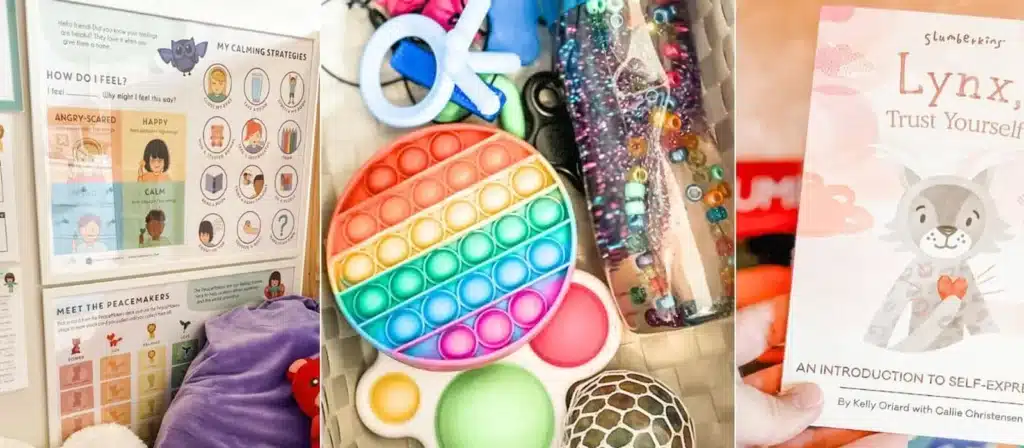
Art materials allow children to express their creativity and emotions. Including these items in a calming corner can provide a therapeutic outlet for stress and anxiety.
- Coloring Books
Coloring books are a simple yet effective way for children to relax. The repetitive action of coloring can be soothing and meditative. - Drawing Supplies
Providing drawing supplies such as paper, crayons, markers, and colored pencils gives children the freedom to create. Art can be a powerful self-expression and help children process their feelings. - Craft Kits
Craft kits that include materials for making simple projects can also be a great addition. These kits can engage children in a focused activity, taking their mind off their worries.
Engaging in art activities allows children to express themselves creatively. It can be a calming and enjoyable way to spend time, helping to reduce anxiety and improve mood.
5. Deep Breathing Material
Deep breathing is a simple but effective way to reduce stress and promote relaxation. Including materials that teach and encourage deep breathing can be beneficial in a calming corner.
Deep breathing helps to calm the nervous system and reduce anxiety. Teaching children this technique can give them a valuable tool for managing stress.
- Breathing Exercises Posters
Posters that illustrate deep breathing exercises can guide children through the process. Visual aids can make it easier for children to understand and practice these techniques. - Breathing Toys
Breathing toys like pinwheels or bubbles can make deep breathing exercises fun and engaging. These toys encourage children to take slow, deep breaths, which can help them relax.
6. Calm Corner Sign

A clear, welcoming sign designating the space as a calming corner helps children recognize and understand its purpose. This sign should be inviting and easy to read.
- Design Elements
The sign should include calming colors and simple, positive messages. Phrases like “Take a Break” or “Relax Here” can make the space more inviting. - Placement
Place the sign at eye level for children. It should be one of the first things they see when approaching the calming corner, making it clear that this is a particular, safe space for them.
7. Emotion Chart Poster
Emotion chart posters are valuable tools for helping children identify and express their feelings. These posters typically display a range of emotions with corresponding facial expressions, providing a visual aid for children to understand and communicate their emotional states.
Emotion charts come in various designs, from simple smiley faces to more detailed illustrations. Choose a chart that is age-appropriate and easy for children to interpret.
Place the emotion chart at eye level so children can easily see and refer to it. Encourage them to point to the emotion they are feeling, which can help them articulate their emotions more clearly.
8. Sandglass Timer
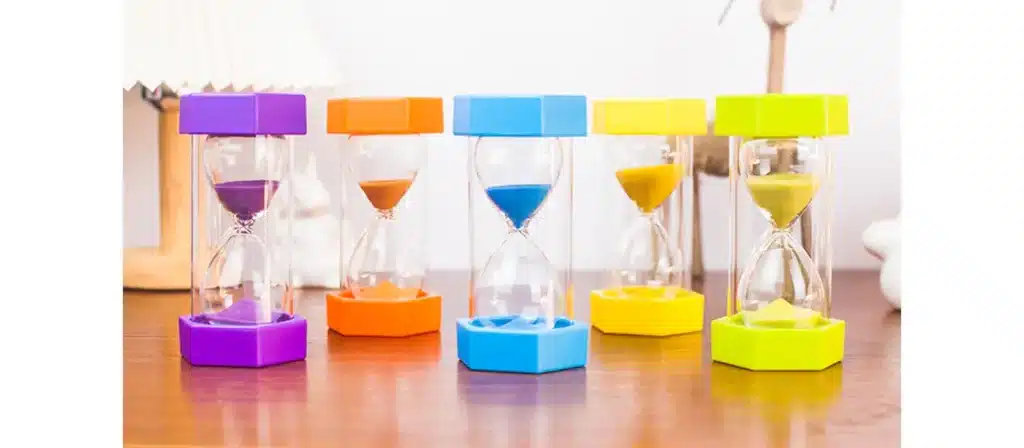
Sandglass timers come in different durations, typically one to five minutes. Various timers allow children to choose the one that best suits their needs. Use sandglass timers to set specific periods for calming activities, such as deep breathing or quiet reflection. Watching the sand flow can be mesmerizing and help children relax.
Sandglass timers can help children develop a sense of time and patience. They provide a structured way to practice mindfulness and can be a valuable tool in the calming corner.
9. Soft Carpet
A soft carpet can define the calming corner and provide a comfortable area for children to sit or lie. The tactile sensation of a soft carpet can be very soothing and help create a cozy atmosphere.
Types of Carpets
Choose carpets made from plush, soft materials that are comfortable. Consider colors and patterns that are calming and not overly stimulating.
Placement
Place the carpet in a designated classroom area where the calming corner will be. Ensure that it is large enough to accommodate multiple children if necessary.
10. Comfort Items
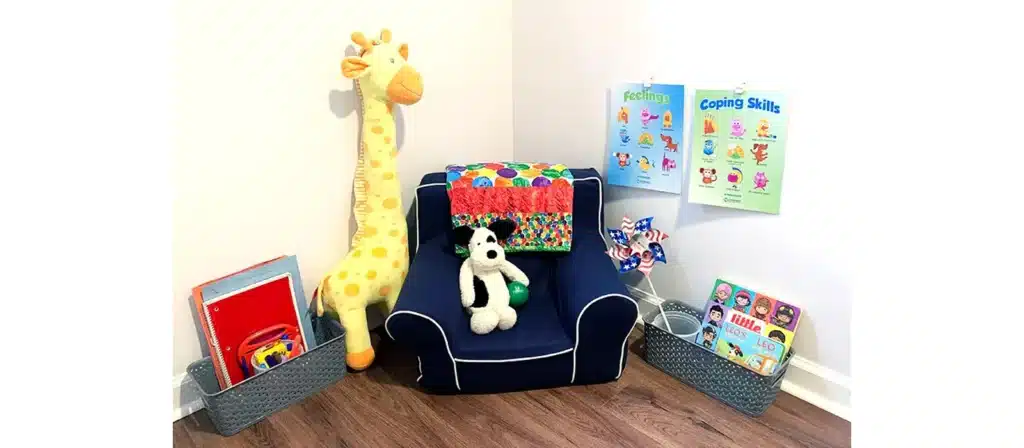
Comfort items like plush toys and blankets can provide security and familiarity. These items are especially helpful for younger children who may need extra comfort.
- Plush Toys
Soft, cuddly toys can be exceptionally comforting for children. Choose toys that are safe, easy to clean, and age-appropriate. - Blankets
Blankets provide warmth and a sense of enclosure. Opt for soft, lightweight blankets that children can quickly wrap around themselves.
11. Sensory Items
Sensory items can help children self-regulate by providing tactile, visual, or auditory stimulation. These items are particularly beneficial for children with sensory processing needs.
- Sensory Toys
Sensory toys such as stress balls, fidget spinners, and textured items provide tactile stimulation. These toys can help children release tension and focus their energy. - Sensory Bottles
Sensory bottles filled with glitter, beads, or water create visual stimulation. Watching the contents move can be calming and help children relax.
12. Visual Aids

Visual aids provide clear instructions and support for children using the calming corner. They can reinforce positive behaviors and techniques, helping children develop healthy coping strategies.
- Breathing Exercise Posters
Posters illustrating breathing exercises can help children learn and practice deep breathing techniques. These visual cues can be beneficial for younger children. - Positive Affirmation Charts
Charts with positive affirmations can boost self-esteem and encourage. These charts can remind children of their strengths and capabilities.
13. Fidget Toys
Fidget toys are excellent for helping children self-regulate and focus. These small, tactile items can be squeezed, twisted, or manipulated in various ways, providing sensory stimulation to help calm anxious feelings.
Many fidget toys include stress balls, fidget spinners, and textured items. Each type offers different sensory experiences, allowing children to find what works best.
Fidget toys can help children release nervous energy and improve concentration. They are particularly useful for children with difficulty sitting still or focusing on tasks.
14. Stuffed Animals
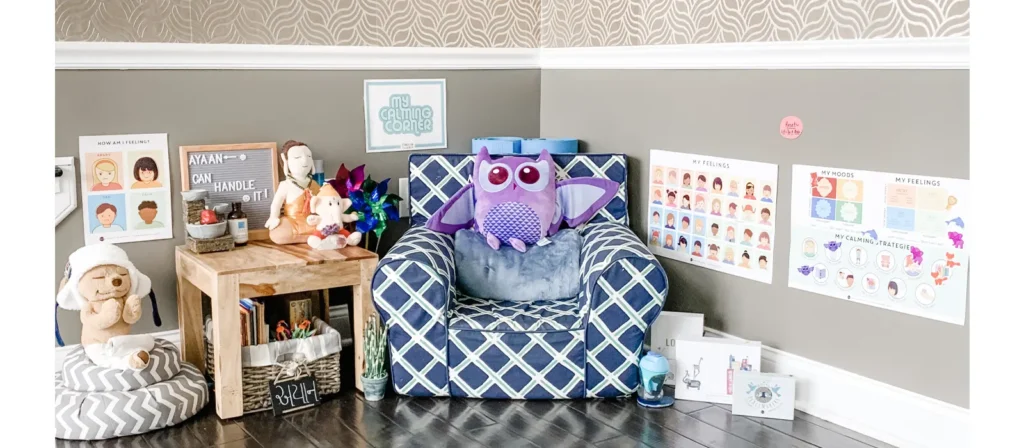
Stuffed animals can be incredibly comforting for children. These soft, cuddly toys provide a sense of companionship and security, helping children feel less alone.
Choose stuffed animals that are soft, washable, and durable. Ensure they are appropriate for the age group in your classroom and accessible from small parts that could be a choking hazard.
Stuffed animals can help children feel more secure and provide a tangible object to hold onto during stressful moments. They can also serve as a tool for imaginative play and storytelling.
15. Painting Materials
Provide various materials, including watercolor paints, brushes, paper, and easels. Ensure that all materials are safe and non-toxic.
Painting allows children to express their emotions visually. The process of creating art can be very calming and therapeutic, helping children to relax and focus.
16. Plasticine
Plasticine, or modeling clay, is another excellent tool for the calming corner. It allows children to use their hands to create shapes and figures, providing a sensory and creative outlet. Provide a variety of plasticine colors and tools in the calming corner. Encourage children to use it to create whatever they like, allowing their creativity and stress to melt away.
Choose a non-toxic, easy-to-mold plasticine in various colors. Ensure it is soft enough for young children to manipulate but firm enough to hold its shape.
Conclusion
Creating a practical calming corner in the classroom involves incorporating a variety of items that cater to different sensory needs and preferences. From comfortable seating to noise-canceling headphones, books, art materials, and breathing aids, each item is crucial in providing a serene and supportive environment. This calming corner can help children manage their emotions, reduce stress, and improve their overall well-being, contributing to a more harmonious learning environment.

